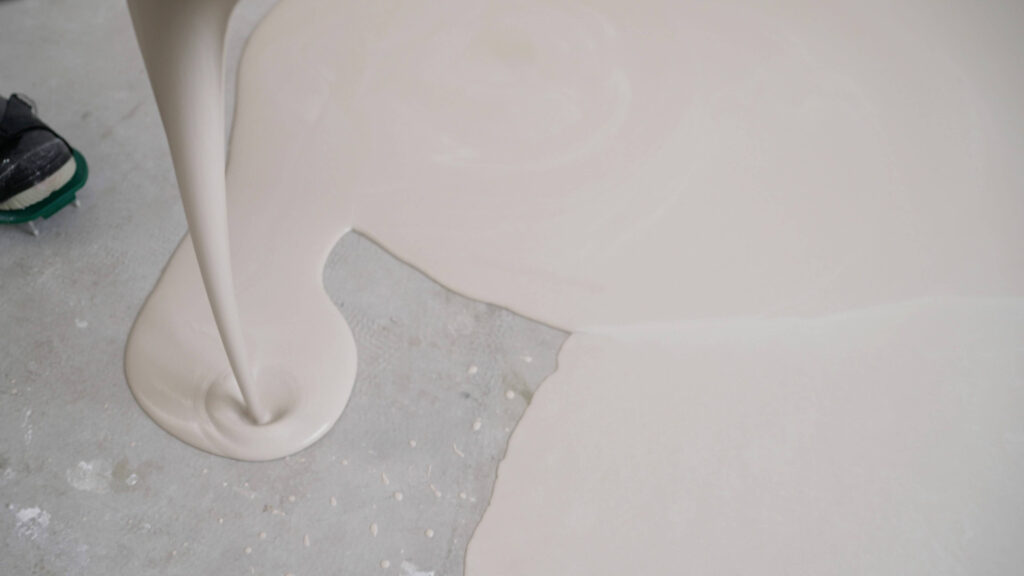Self-leveling types of cement are a modern solution for leveling and repairing concrete floors, providing technical soundness and cost-effectiveness, especially in the context of commercial remodeling/renovation projects, cost reduction efforts in new construction, and the decreasing availability of skilled cement finishers..
Advantages of self-leveling cements over traditional trowel-able underlayments include:
- Application speed: About eight times faster than trowelable underlayments.
- Lower expertise requirement: They do not demand the same high level of expertise as hand troweling.
- Versatility: This can be used to repair various substrates.
- Fast-setting: Can be walked on in a few hours.
- Quick floor installation: Floors can usually be installed the next day.
- Minimal shrinkage: Can be installed from a feather-edge to several inches in one pour with little or no shrinkage.
- High compressive strength: Develop high compressive strength (4000 PSI or greater).
- Water-resistant: They are water-resistant and do not promote the growth of microbial contaminants.
Self-leveling doesn’t mean simply pouring the mixed batch to the center of the room and letting it settle on its own. It means the mixture of powder and water has low enough viscosity to allow the material to seek its own level before setting.
Recommendation:In your transformative journey with self-leveling cements, consider using Powerhold 650 Polymer Fortified Portland Cement Patch Plus. This true multipurpose cementitious patching compound and skim coat offer a smooth and creamy consistency. This polymer-modified product delivers quality and performance without compromise. Adjust the liquid-to-powder mix ratio to use it as a true skim coat or patch, providing versatility for various applications.
Substrate Preparation:Proper preparation of the concrete surface is crucial for a good bond with the self-leveling underlayment. The surface must be sound, clean, and free of residuals like oil, grease, wax, dirt, sealers, curing compounds, and adhesives. Shot-blasting is often used to ensure a clean and contaminant-free substrate.
Priming:Most self-leveling products recommend the use of primers to act as bonding agents. The choice of primer depends on whether the substrate is porous or non-porous.
Additives:On special types of substrates, additives may be recommended for additional bonding strength and flexibility.
Temperature Control:Temperature control is crucial for successful self-leveler use. Monitoring ambient temperature, slab temperature, powder temperature, and mixed water temperature is essential. Temperatures exceeding 70 degrees Fahrenheit can be detrimental to the application.
Drying:Drying usually takes about two hours before walking on the surface and allows for the installation of resilient floors the next day. Care must be taken to prevent the underlayment from drying too fast to avoid surface cracks.
Priming the Surface:Priming is necessary, and the type of primer depends on whether the surface is porous or nonporous. Using a primer ensures a good bond to the substrate and can prevent future problems.
Mixing:Correct water-to-powder mixture is critical. Mixing involves adding the correct amount of powder to pre-measured water, power mixing with a heavy-duty drill for about two minutes, and then pouring the mix onto the floor without delay.
Spreading:After mixing, pour the mix onto the floor and move it with a spreader to achieve a uniform thickness. The spreader is a stand-up, handheld device that can be set to apply the desired thickness.
Smoothing:A smoother, hand-held device, is used for final smoothing by removing spreader marks, footprints, and irregularities.
Working Time:Working time varies from eight to 10 minutes, depending on the temperature.
Pumping:For large installations, self-leveling underlayments can be pumped, controlling the critical water-to-powder mixture for faster installation. A three-person crew can cover a large area per hour using a pump.
Attribution: This content is based on information from ProInstaller Magazine.



